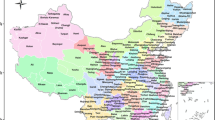Abstract
The demand of water is increasing with the socioeconomic development, and the contradictions between supply and demand of water resources in regional scale have become increasingly intensified. Scientifically evaluating the risk caused by the contradictions between supply and demand of water resources has become a useful way to solve the imbalance of water resources effectively. In the current study, the utilization of water resources in Songliao Basin was analyzed based on the water quantity, water quality, and socioeconomic data in 1999–2006. Accordingly, a risk-evaluation index system of water resources utilization was generated, which included ten indicators, such as the total quantity of regional water resources. Three common factors (i.e., high water-demand, high water-supply, and low-quality water) were identified by factor analysis. These factors were then evaluated with spatial clustering. Thus, the risk distribution of water resources was made in the study area. The results indicate that (1) the pattern of water resources utilization in Songliao Basin was high risk in Songnei Plain and low risk in Changbaishan Mountain, and (2) Nenjiang and Songhua Rivers were high risk; however, Tumen and Wusuli Rivers were low risk.





Similar content being viewed by others
References
Bongartz K, Steele TD, Baborowski M, Lindenschmidt KE (2007) Monitoring, assessment and modelling using water quality data in the Saale River Basin, Germany. Environ Monit Assess 135:227–240
de Oliveira DP, Garrett JH Jr, Soibelman L (2010) Detecting plant spatial patterns, using multidimensional scaling and cluster analysis, in rural landscapes in Central Iberian Peninsula. Landsc Urban Plan 95(3):138–150
Feng LH, Huang CF (2008) A risk assessment model of water shortage based on information diffusion technology and its application in analyzing carrying capacity of water resources. Water Resour Manag 22(5):621–633
Fujihara Y, Tanaka K, Watanabe T, Nagano T, Kojiri T (2008) Assessing the impacts of climate change on the water resources of the Seyhan River Basin in Turkey: use of dynamically downscaled data for hydrologic simulations. J Hydrol. 353(1–2):33–48. See http://apps.isiknowledge.com/summary.do?qid=1&product=UA&SID=3APJ%40nf7ihHgiKc1jgD&search_mode=GeneralSearch
Garcia-Abad JJ, Malpica JA, Alonso MC (2010) Detecting plant spatial patterns, using multidimensional scaling and cluster analysis, in rural landscapes in Central Iberian Peninsula. Landsc Urban Plan 95(3):138–150
Han YP, Ruan BQ (2008) The Comprehensive Assessment of Water Shortage Risk Based on GIS. J Irrigation Drainage 27(2):9–12
Hu QH, Huang TZ (2007) Risk evaluation of conflicts of river basin water resources. Stat Decisi 2:34–37
Hu QH, Shi GQ, Huang TZ (2007) Application of nonlinear FCA model to risk evaluation of conflicts of river basin water resources. Adv Sci Tech Water Resour 27(2):6–9
Huang MC, Xie JC, Ruan BQ (2007) Model for assessing water shortage risk based on support vector machine model for assessing water shortage risk based on support vector machine. J Hydraul Eng 38(3):255–259
Kuo JT, Hsieh PH, Jou WS (2008) Lake eutrophication management modeling using dynamic programming. J Environ Manag 88(4):677–687
Lermontov A, Yokoyama L, Lermontov M, Machado MAS (2009) River quality analysis using fuzzy water quality index: Ribeira do Iguape river watershed. Brazil Ecol Indic 9(6):1188–1197
Li XY (2005) Research on methods and application for urban spatial data mining. Shandong University Press, Jinan
Li XY, Li DR (2005) DBSCAN spatial clustering algorithm and its application in urban planning. Sci Surv Mapp 30(3):51–53
Li XY, Zheng XQ, Yan HW (2004) Research on spatial clustering of combination of coordinate and attribute. Geogr Geo-Inf Sci 20(2):38–40
Liu T, Shao DG, Gu WQ (2006) Risk comprehensive evaluation of water supply in middle and lower reaches of Hanjiang River after implementation of middle route of South-to-North Water Diversion. Eng J Wuhan Univ 39(4):25–28
Luo JC, Zhou CH, Liang Y (2002) Scale-space theory based regionalization for spatial cells. Acta Geographica Sinica 57(2):167–173
Min QD, Yu WD, Zhang JX (2004) Fuzzy-based evaluation of water resources carrying capacity and its application. Res Soil Water Conserv 11(3):14–17
Okuda K (2008) Coastal environment and seaweed-bed ecology in Japan. Kuroshio Sci 2(1):15–20. See https://ir.kochi-u.ac.jp/dspace/handle/10126/3157
Pan XY, Xia J, Li FH (2007) Applied study on evaluation method for water resources carrying capacity based on GIS techniques in typical North District. J Nat Resour 22(4):664–671
Ruan BQ, Han YP, Wang H (2005) Fuzzy comprehensive assessment of water shortage risk. J Hydraul Eng 36(8):906–912
Song XL, Yu J, Sun HZ (2006) The application of Fuzzy synthesis evaluation in risk evaluation. Microcomput Inf 22(12–3):71–79
Tsai CF, Tsai CW, Wu HC, Yang T (2004) A novel data clustering approach for data mining in large databases. J Syst Softw 73(1):133–145
Wang YF, He HL (2007) Spatial data analysis methods. Science Press, Beijing
Wong KTM, Lee JHW, Harrison PJ (2009) Forecasting of environmental risk maps of coastal algal blooms. Harmful Algae 8(3):407–420
Zhang YW (2006) Spatial clustering based model for regional edonomical data analysis. Econ Geogr 26(4):557–560
Zhong P, Shen ZY, Yang ZF (2005) Determing the sensitive factors for water resource scarcity fisk in Shiyang River basin. J Arid Land Resour Environ 19(2):81–86
Acknowledgments
The current study was sponsored by the National Basic Research Program of China (No. 2010CB951102 and 2012CB955403), the Science and Technology Support Plan (No. JD2010-6), the Open Projects Foundation of Key Laboratory of Soil and Water Conservation and Desertification Combat (Beijing Forest University), and the Ministry of Education (No. 201007). The authors are grateful to the journal's editor and anonymous reviewers for their constructive comments on earlier version of the paper.
Author information
Authors and Affiliations
Corresponding author
Rights and permissions
About this article
Cite this article
Zhang, X., Xu, K. & Zhang, D. Risk assessment of water resources utilization in Songliao Basin of Northeast China. Environ Earth Sci 67, 1319–1329 (2012). https://doi.org/10.1007/s12665-012-1575-5
Received:
Accepted:
Published:
Issue Date:
DOI: https://doi.org/10.1007/s12665-012-1575-5




